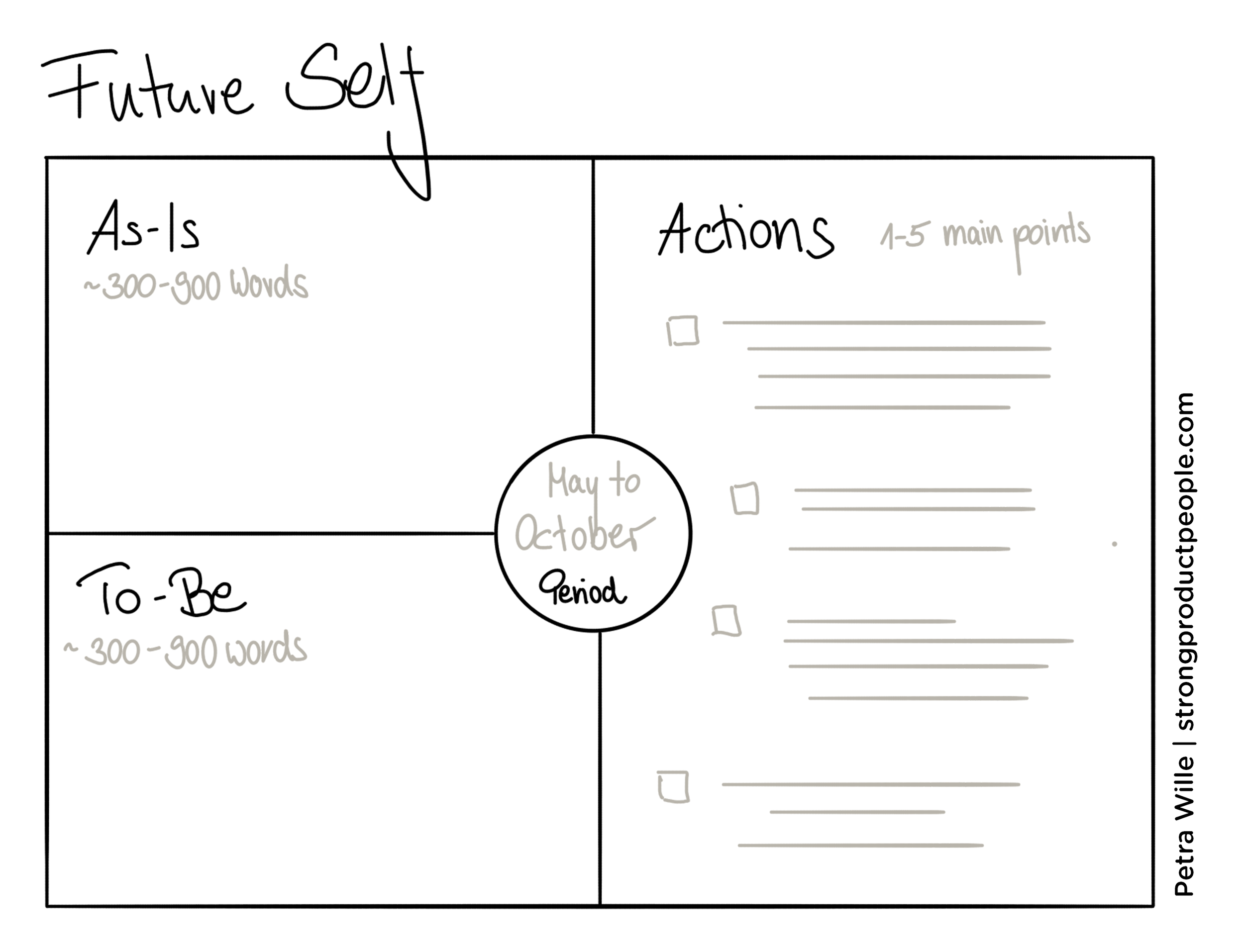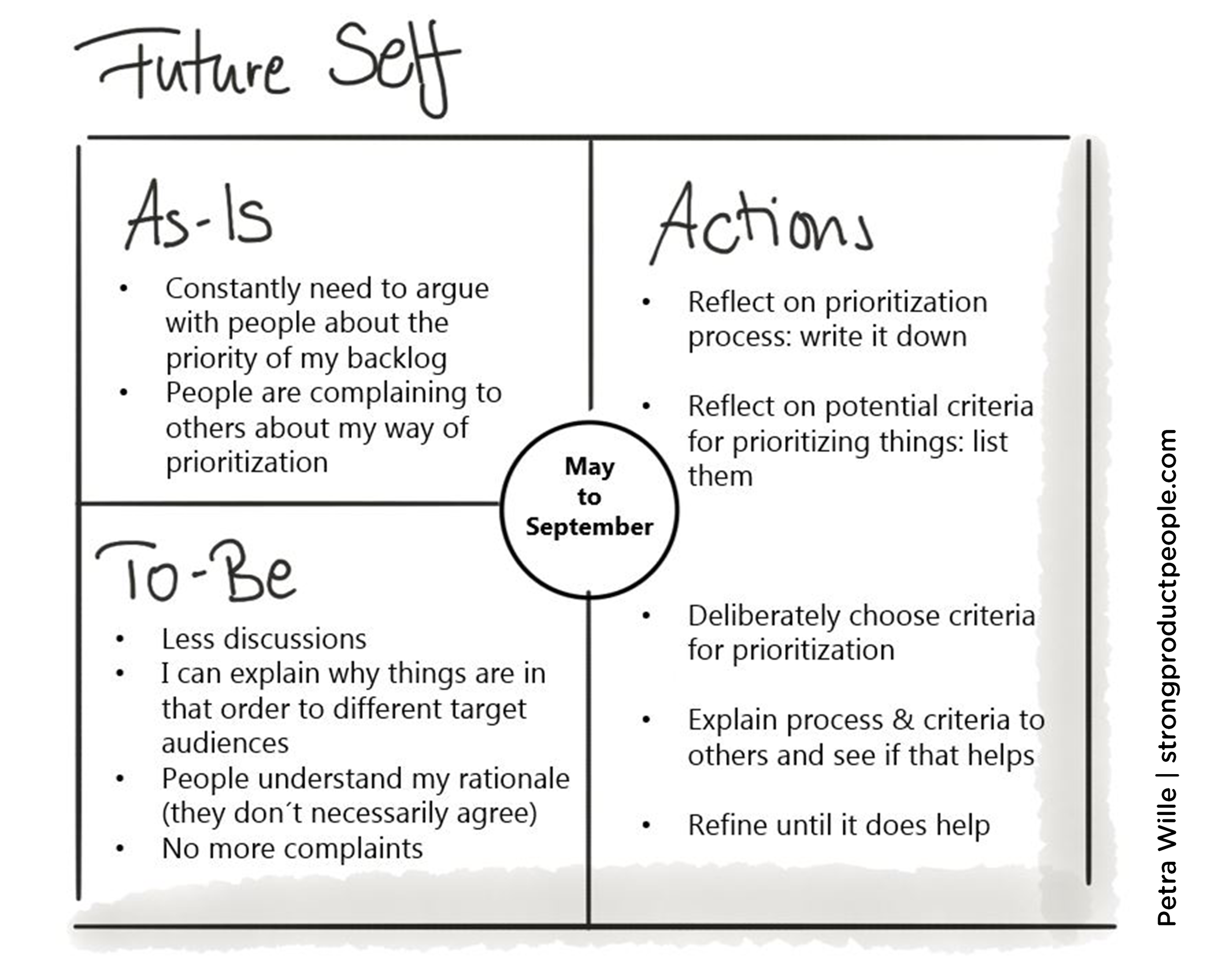A lightweight way to create a development plan for PMs - the Future Self
Note: This is written for PMs, but I’m sure product leaders will get the idea: The Future Self is a great exercise for the 1:1s and career conversations with your PMs. If you want to learn more about it, feel free to get in touch.
Let’s assume you are a product manager and you know or have figured out what your next big development topic is (e.g. by using the PMwheel). You then should come up with something I would call a development plan. Something that helps you commit to small actions that get you closer to the competent product management personality you want to become.
I like to use the Future Self template that originates from the book FYI: For Your Improvement published by organizational consultancy Korn Ferry.
The Future Self framework (download PDF version) takes the form of a document that you need to fill out, and it has four parts:
As-Is: This is your current situation.
To-Be: This is how you see yourself after you have worked on or gained competency in a particular skill.
Actions: This is a list of actions that will help you get closer to your Future Self.
Timeframe: How long do you think this should be your self-development focus topic?
The four-part template explained
As-Is should be around 300–900 words, 10 sentences minimum. I suggest asking three to five of your peers about the status quo for the As-Is part.
To-Be should be as precise as possible. What are the things other people will recognize in a few weeks or months from now? What has improved? That should land around 300-900 words as well.
Actions: List three to five actions, no more. If you are familiar with BJ Fogg’s concept of tiny habits, applying this may be very helpful. If it’s a super big development topic that you want to become better at, maybe do a follow-up version of the future self and start small. Pro Tips:
Think about who could be your accountability buddy on this. Maybe it’s your line manager, maybe somebody from your product development team. But chances for success are much higher if you find a partner in crime and ask them to remind you to work on your actions constantly.
Ask yourself “How do I learn best?” and make use of this insight if you want to learn a new skill. For some people that’s reading a book, watching a talk, listening to a podcast, or reflecting on their learning and explaining it to others.
See if you can find other PMs with the same development topic and start a small learning group. You will positively influence each other and you’re more likely to be successful.
Make sure the actions are challenging but not stressing you out too much. Balance is key here.
Timing: In my experience, it’s hard to keep up the spirit for change for more than three to four months at a time. List whatever you think would help such as additional training, even if that would cost some money. Discuss this with your line manager in one of your next 1:1 sessions.
Meet Sarah and how she uses the Future Self
Meet Sarah. She is a product manager in a Europe-based FinTechcompany, and she constantly finds herself in situations where she is defending the priority of the items on her backlog. She has endless discussions with her product development team, stakeholders, upper management, and even with customers. So prioritization might be one of her weaker competencies.
Sarah heard via some colleagues that people are complaining that “she doesn't know how to prioritize” and “has no clue what to put on the backlog.” They are talking about her behind her back! Not a nice situation to find herself in. But a great moment to start the Future Self exercise. So she uses these exact points for our As-Is description.
Please note: I totally over-simplified this example. So please, be a bit more descriptive if you are filling out your own Future Self.
Once that is done, she starts to think about her To-Be. The first thing that comes to her mind is: “If I could have less of these discussions and people would stop complaining about my prioritization skills, that would be great.” So she adds that to her canvas.
Then she decides to talk to several colleagues about the topic (“Hey, I want to up my prioritization game. What did you do to become good at that?”) and figures out that it’s not so much prioritization techniques she is missing—it’s more the storytelling part where she needs to improve. She just hasn't spent enough time on creating and telling a story around her approach to prioritization. And that's something she thinks she can change. She might need to reflect on the criteria she uses for prioritization, but that's something she would like to do.
This gives her some ideas for the Actions part of the canvas. She thinks she needs to reflect on the prioritization process she is currently using. Currently, it’s something she does daily, but now that she reflects on it, she wouldn’t be able to explain her way of prioritizing things to others. So that definitely has to change.
And she for sure needs to talk to colleagues more to figure out how they prioritize and which criteria they deliberately chose.
Once this is done, she needs to start to share the rationale behind the order of her backlog with others and see if that helps. And if it doesn’t, she needs to tweak the story until she reaches her To-Be state.
Creating your own development plan is hard
Creating a Future Self on your own is hard. I know. And, let me be frank here, it’s not ideal if you need to do this alone. It’s way easier if a skilled people manager—somebody really invested in coaching product people—is helping you with this. So ask your line manager for help.
And if their response is, “I don’t know how to help,” send them my way. It’s my mission to help product leaders become great coaches for their product people.
If you think somebody in your organization would benefit from that type of guidance, send them to my website strongproductpeople.com.
My book STRONG Product People will launch in early 2021. Sign up for the waitlist here.
The 52 Questions deck of coaching cards is like a mini product coach in a box. Many teams use the questions to prompt discussions around growth and development. Order your deck here.
I offer coaching for product leaders and I’m happy to talk about what coaching might look like for your organization. You can learn more about my coaching offerings here.
And if there is no such person (a line manager that cares deeply about your personal development as a product manager), please try to find a senior product manager in your company and ask them for help with creating your development plan.
Or, reach out to the lovely product community and find somebody with the same challenge. Here are a few great Slack channels to check out:
Mind the Product Slack Community (+40.000 people)
Women in Product Slack Community (+7.000 people)

